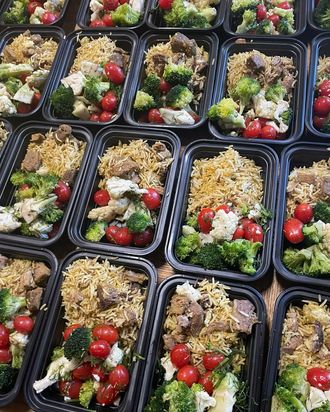
Since the spring of 2022, New York City has received some 165,000 migrants and asylum seekers. Today, some 70,000 of them are staying in city shelters, including at places, like Floyd Bennett Field, that are distant from city services. New York has spent more than $2.4 billion on the crisis, and Mayor Eric Adams has blamed the situation for significant budget cuts. How to house and feed all of these people remain ongoing concerns: In December, the New York Times reported that a company called DocGo, which had won a no-bid contract to provide a range of services, was throwing away thousands of meals a day. Migrants have complained that DocGo’s food is moldy and inedible. Many in the restaurant industry have stepped in to help feed these people, some continuing or building on work and networks developed during the pandemic. One of these restaurateurs is Beatrice Ajaero, who runs the West African takeout shop Nneji in Astoria. We spoke with her about her work feeding asylum seekers and other migrants, how she thinks about food access, and making meals that can speak to multiple cultures.
I was wondering if you could tell me about your work feeding migrants. How did you you get involved?
It started with food-access work we did in 2020. We had been planning to open up our business in Astoria when the pandemic hit. With the market closed, we were doing door-to-door deliveries on Roosevelt Island. When we opened, we were approached by local nonprofits like Queens Together to support Astorians who were impacted in their ability to feed themselves, their families here, and their families abroad.
We really were compelled to play a role in that, to make plant-based, highly nutritious prepared meals that are culturally responsive. Our meals are halal. It’s part of our faith-practice definition of food access. Quite frankly, if we could be kosher certified, we would be.
In our work with Queens Together, Food First, Rethink Food — with many partners — we’ve really just been looking to define this food-access space broadly. As we welcome new neighbors from West Africa and from Latin America, we begin to elevate this question of making meals that are highly nutritious and culturally responsive.
You’re talking about serving culturally appropriate meals. There has been some reporting about the city’s contract with DocGo, and the reported lack of care going into that food.
You have a great number of individuals and families — some with toddlers, babies, and newborns — coming into the city. You’ve got several layers of considerations for nutrition, for culture, for dietary restrictions, for allergies. The city has a lot of different factors to consider when sending meals out to all the many different places where migrants are settling in.
When we are able to make meals that are highly nutritious, we also get to help mitigate the stress people are experiencing from having traveled so far from home. What better than a nourishing plate of food, where they have ingredients that can remind them of a positive experience? We hope to lift some spirits and also the nutrition of what people consume. In addition to thinking about serving migrants where they are, many of the children are also coming into schools. The work that’s being done, with the mayor’s Chefs Council, to have culturally responsive meals in schools will be increasingly important.
On our end, we’ve been curating menus where we may combine certain spices, grains, and plant-based proteins, so that even if the lines that form are very diverse, our hope is that a meal can speak to a few countries or a few palates at once. That’s what we’ve been working hard to do.
How does that work in practice?
We think deeply about where the meals are going when we prepare them, and we know that there’s a diversity of migrants who are coming into the city. We’re not just, as a West African restaurant, looking to present fully West African meals. We may make an American-style chili that has another touch point. We may use a slightly pungent, probiotic bean-based spice from West African cuisine along with cumin, so it’s not so overpowering. When someone from South Asia tastes the spice, there’s familiarity there, as there is for someone from West Africa. The chili also gives a frame of reference. Now, to someone eating it, not only are they connecting with the familiarity of the spice, but they’re also learning about America’s cuisine as they acclimate.
Using basmati rice often allows us to speak to people from many places. It has one-third of the carbohydrate count, so it helps us with folks who are watching their glycemic levels. When we use chickpea or black bean, we can reference the arroz con frijoles dishes a lot of our Latin American neighbors eat. We really try to see that a couple of cultures or cuisines are honored when we send our meals out the door.
As a practice, we have paired every meal with a Sicilian roll from Rose & Joe’s. Across cultures, bread is very essential, and as New Yorkers, we wake up to a lot of bread products. A lot of folks who are coming here are not able to join us in that tradition. We hope that they feel like they’re starting the day with the rest of the city before being given a chance to bounce back.
How many meals are you cooking each week?
It does fluctuate, but right now we do 500 meals a week for Jacob A. Riis Neighborhood Settlement, which is an organization that has a range of constituents. But it’s also in the heart of an area where a lot of migrants are. In some instances, we may be doing 200 meals at a time for a shelter directly. Throughout the year last year, we did 200 meals every Friday for Masjid Ansaru-Deen in the Bronx, which also houses migrants in the business. We would also do 200 for the madrasa in Harlem. We make fonio, we make red stew, and if we know it’s going to a place with many West African migrants then we may emphasize West African cuisine. But, again, always using spices that allow for broader familiarity. We may use cilantro in the fonio, which is an important grain across the Sahel — I can’t say that many Sahelians would usually see cilantro in that grain. But we do it because we know Latin Americans are fond of it, they can at least say I know this part of the dish.
How do you approach the work of feeding migrants, versus nurses and doctors, or whoever else, during 2020? There are different challenges and needs to meet, right?
In 2020, I’d say we didn’t do a lot of meat-based proteins, because we wanted proteins that were easier to digest for frontline workers. At the same time, the migrant families are sometimes on their feet all day. We know that families are going from pantry to pantry. They’re sometimes going to the bottle deposit. They’re sometimes going to stand in line in an office where they have long waits. Their days can be very long. We’ve tried to make meals that can be eaten at room temperature, that are still robust. We think about that for folks who may be on the move. We know that there’s a cut-off time to get back to the shelters. You have to be mindful about where people are, when they’re going to get their food, how long they’re going to be outside.
All the various organizations that you work with, like Queens Together and so on. In the distribution of these meals, you’re doing this through these partner organizations, or are you also directly distributing meals yourself?
When we partner with nonprofits in the area, they often give us a cover of a coverage risk, mostly the cost of the materials. We put in the logistics, labor, transportation, and all the other pieces in the packaging. There are times where organizations are not able to do more and we still want to make sure that families have what they need. We’re keen to donate meals all the time. We believe in this beyond what budgets are able to do, which is why we put in so much of our own resources.
We’ve continued to do meal distributions through Astoria Welfare Society for halal fridges and to partner with other nonprofits like iDig2Learn on Roosevelt Island. It’s a part of who we are. 9 Million Reasons is one of the largest food distributions in Long Island City, seeing over about nine migrant shelters. They’re a really big asset to many migrants and many neighbors in the area, so we do a lot to support them.
The charge, which is not always an easy one, is how do we curate the foods that go out to new migrants with all these different layers of consideration? Moving beyond just a meal that comes to them, to one that can nourish them with culture, allergens, nutrient density, dietary strictures, and faith practice all in mind. These are important questions we’ve spent a lot of time thinking about.
The city has a lot of pieces. It’s a big ship. It takes a lot of very dedicated hands and I am grateful that the city has so many from the mayor’s office to Assemblymember Zohran Mamdani’s office, and all the partners that are working together, like Councilmember Julie Won.
I wanted to bring up Councilmember Won because of some comments she had made on Fox 5 arguing that the city should be awarding contracts to local restaurants. Have you spoken about this?
I’ve had a chance to speak with her in Sunnyside where there was an effort to bring a hot breakfast option for families there. She has many shelters in her network as well. She’s also someone who supported us with work through Queens Together. It’s a conversation that I’m continuing to have with her office. She knows that I’d like restaurants to have an increased role in this because Queens is seeing more and more migrants and we have the capacity and know-how to respond to that.





